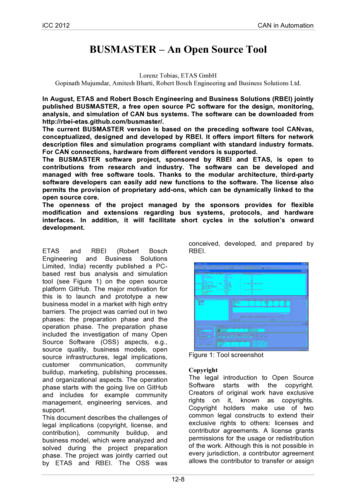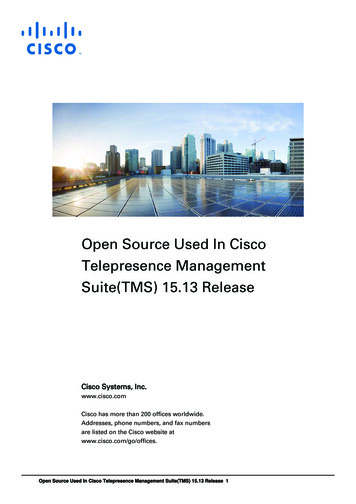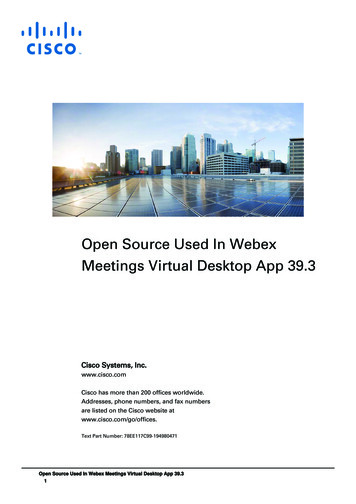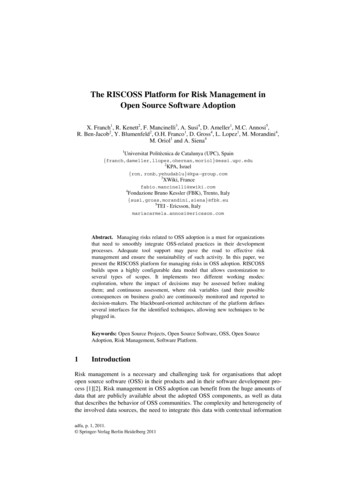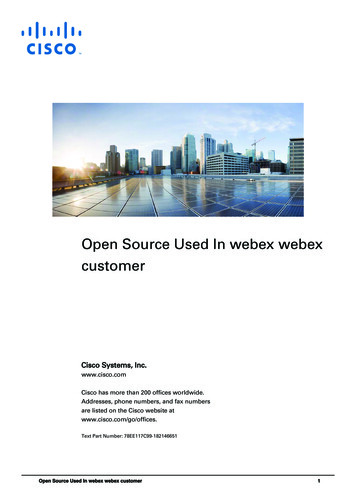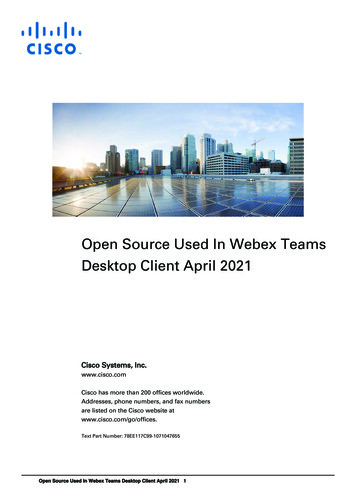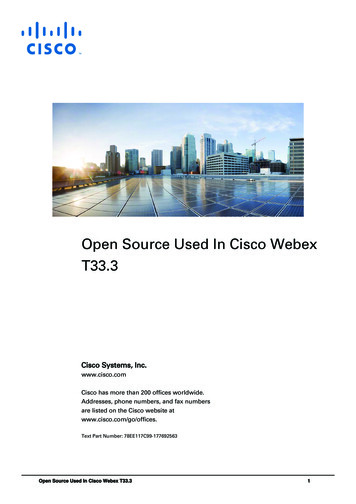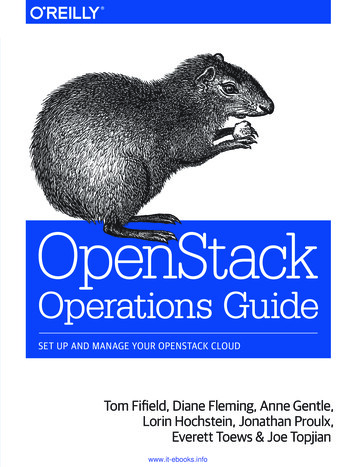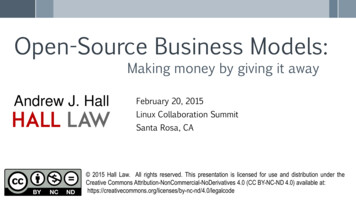
Transcription
Open-Source Business Models:Making money by giving it awayAndrew J. HallFebruary 20, 2015Linux Collaboration SummitSanta Rosa, CA 2015 Hall Law. All rights reserved. This presentation is licensed for use and distribution under theCreative Commons Attribution-NonCommercial-NoDerivatives 4.0 (CC BY-NC-ND 4.0) available .0/legalcode
Presentation Overview› Open-Source Business Models› Open-Source Developmentwww.thehalllaw.com
Open-Source Business Modelswww.thehalllaw.com
Open-source Business ModelsOpen-source business models usually rely upon one or more ofthe following strategies:1. Dual-licensing proprietary company software;2. Providing commercial or enterprise versions, plugins, orextensions to open-source products;3. Offering maintenance, support, consulting, or other servicesthat support or complement open-source products;4. Offering hosting, warranty, indemnity, or other products thatcomplement open-source products; and5. Closed-source modified distributions of open-sourceproducts.
Open-Source License TypesLicense TypeIntended Copyleft EffectPermissive(Apache-2.0, BSD)NoneWeak Copyleft(LGPL, MPL, CDDL)Modifications/enhancementsto the open-source softwareStrong Copyleft(GPL, AGPL, OSL)Certain software distributed incombination with the opensource software.Network Strong Copyleft Certain software distributed or(AGPL, OSL-3.0)hosted in combination with theopen-source software.Prohibitive(Ms-LPL, BCLA)Typically none, but specificuses (e.g., commercial) areprohibited
1. Dual Licensing (1/2)› Company offers its own proprietary software for use under either of(a) an open-source license or (b) a paid commercial license.› The open-source license often prohibits or limits commercial use of thesoftware. Licensees wishing to avoid such prohibitions and limitationscan purchase a commercial license with more favorable terms.› Commercial licenses may additionally or alternatively:(a) provide access to company services (e.g., support, maintenance,and customization);(b) include warranties or indemnification not available under the opensource license;(c) provide early access to updated versions of the software; or(d) resolve infringement allegations made by the licensor.
1. Dual Licensing (2/2)› Examples:MySQL, BerkeleyDB, Java EE/SE, MongoDB,Asterisk, Modelio, iText, Wurfl, Qt.› Challenges:– Third parties may fork the software creatingalternative implementations (e.g., MySQLforks MariaDB and Drizzle)– Collecting fees may require unpopularlicensing campaigns targeting the software’suser base.
2. Open Core & Open Platform (1/1)› Open Core (Freemium): Company offers aversion of its product under an open-sourcelicense while offering enhanced or “enterprise”versions of the software under a commerciallicense.› Examples: Sendmail, Java EE/SE, SourcefireSnort, Qt, SugarCRM› Challenges:– Potential for forking and third-party premiumextensions– Limiting access to premium versions cannegatively impact community response andadoption
2. Open Core & Open Platform (2/2)› Open Platform: Company releases aplatform or other software under an opensource license and offers proprietary plug-ins,extensions, applications, or content undercommercial licensing terms through theplatform.› Examples:WordpressAndroid,Eclipse,Hadoop,› Challenge:Successoftenparticularlydependent on broad platform adoption andsometimes third-party participation.
3. Providing Complementary Services› Company offers services that relate to or support customer use of opensource software; software may or may not also be licensed by thecompany.› Related services include, for example, training, customization,implementation, maintenance, certification, and support services.› Selling additional services typically require the company investment ofsignificant additional human or technology resources.› Examples: Red Hat, Canonical, Novell, Pivotal, Palamida, Black Duck.› Challenges:– Third parties can typically provide competitive services with limitedbarriers to entry– Service models typically don’t scale well
4. Providing Complementary Products› Company offers products that complement or heavily depend upon theuse of open-source software.› Related products include, for example, hosting services, hardware andvirtual systems incorporating open-source operating systems andplatforms, and providing warranties and indemnification for open-sourcesoftware and use.› Additional product can typically be sold without significant additionalresource investment from the providing company.› Examples: Red Hat’s “IP Assurance Program” and RHEL build services;MongoDB and AWS hosting services.› Challenges:– Third parties can typically provide competitive products with limitedbarriers to entry
5. Closed-Source Distributions› Company releases commercial (closed-source) versions ofsource originally licensed under a permissive licenseApache 2.0) or offers commercial plugins or extensionsopen-source project or platform. The distributions arespecialized for a particular industry or use case.open(e.g.,to anoften› Examples: Cloudera, Hortonworks, MapR and AWS (offeringcommercial versions of the Apache Hadoop project).› Challenges:– Third parties can offer competitive services;– Success of commercial versions, plugins, and extensions maydepend on the success of the underlying software or platform
Additional Open Source Revenue Models:› Donation-based funding: covering expensescontributions to the project or a related foundation.through› Open-source bounties: companies or communities offeringbounties for bug and security fixes or functional improvements› Crowdfunding: individual, groups, or companies offer toimplement functionality for general release under an opensource license in exchange for a set fee.› Branded merchandising such as merchandise sold by theMozilla and Wikimedia Foundations.› Ad-Supported Software
Open Development (1/2)
Open Development (2/2)
Questions, Comments, Thoughts?Contact:Andrew J. Hallahall@thehalllaw.comwww.thehalllaw.com
Open-source Business Models Open-source business models usually rely upon one or more of the following strategies: 1. Dual-licensing proprietary company software; 2. Providing commercial or enterprise versions, plugins, or extensions to open-source products; 3. Offering maintenance, support, consulting, or other services
